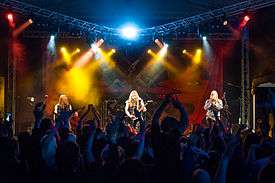Metsatöll
| Metsatöll | |
|---|---|
|
Metsatöll in Lappeenranta, Finland in 2014. | |
| Background information | |
| Origin | Tallinn, Estonia |
| Genres | Folk metal, heavy metal, folk music, Thrash metal |
| Years active | 1999–present |
| Labels | Universal Records |
| Associated acts | Human Ground, Loits, Paskar Kolgats, Aggressor, No Big Silence |
| Website | Metsatoll.ee |
| Members |
Markus "Rabapagan" Teeäär Lauri "Varulven" Õunapuu Raivo "KuriRaivo" Piirsalu Marko Atso |
| Past members |
Silver "Factor" Rattasepp Andrus Tins |
Metsatöll is an Estonian folk metal band. The name "Metsatöll" is an ancient Estonian euphemism for "wolf", which is reflected in the harshness of their lyrics. Much of their material, featuring flutes and other traditional instruments, is based on the wars for independence of the 13th and 14th centuries.
History
Metsatöll started playing together on 24 February 1999 as a three-piece (Markus – vocals and guitar, Factor – drums, Andrus – bass), playing epic heavy metal with small influences from ancient Estonian folklore. The debut album called "Terast mis hangund me hinge" ("Steel frozen in our souls") was released at that time.
In 2000, a good friend Varulven joined the band. So far he had observed the activities of the band and had from time to time joined them on stage. Varulven had self-taught himself a number of ancient Estonian folk instruments and together it was realized that metal and old Estonian folk fit together perfectly. Since then, the music of Metsatöll has intertwined more and more with old Estonian runo-singing and traditional melodies.
2001 was a difficult year for the band, since their bass player Andrus left the band, deciding to attend more to his personal affairs, and considering the band too much of a burden. A new bass player, KuriRaivo, was found after a couple of months.
In 2002 Metsatöll released the single "Hundi Loomine" ('The Creation of the Wolf'), for which a video was also shot (directed by Liina Paakspuu). Hundi Loomine received numerous exceptionally positive reviews and commentaries in the local media, there was talk of the true mind of the Estonians, the destruction of the negative effects of the English language and the rebirth of folklore through contemporary means and people.
In the beginning of 2004 drummer Factor dedicated himself completely to science and he was replaced by Atso.
In late 2004, Metsatöll released their second album, called Hiiekoda (My Home, My Sacred Grove), which was critically acclaimed by both metal and non-metal fans from all over Estonia. It is a heavy metal album strongly combined with old Estonian traditional instruments.
In 2005, Metsatöll released a remake of their old album Terast mis hangund me hinge called Terast mis hangunud me hinge 10218. The number stands for the world's age according to Estonian chronology. It is much more influenced by folk music and done in a much more professional way in general. They have also released a live album called Lahinguväljal näeme, raisk! (See you on the battlefield, sod/bastard!).
In 2009, Metsatöll signed the Finnish record label Spinefarm Records.[1] A new album, titled Äio was released on the 3rd of March. An Internet single, along with the video to a song from the album, called "Vaid Vaprust" was released on the 15th of January.
In 2011, Metsatöll released another album called Ulg. The first song released was Kivine Maa and a video was made for Küü.
In 2012, Metsatöll played on the main stage of Tuska festival in Helsinki. They later released a concert album called Tuska from the same performance.
Members[2]
- Current members
- Markus "Rabapagan" Teeäär –lead vocals, rhythm guitar (1999–present)
- Lauri "Varulven" Õunapuu – guitar, lead vocals, traditional instruments(1999–present)
- Raivo "KuriRaivo" Piirsalu – bass, backing vocals, contrabass (2000–present)
- Marko Atso – drums, backing vocals (2004–present)
- Former members
- Silver "Factor" Rattasepp –drums, backing vocals (1999–2004)
- Andrus Tins – bass, backing vocals (1999–2000)
Discography[3]
Studio albums
- Hiiekoda (2004)
- Terast Mis Hangund Me Hinge 10218 (2005)
- Iivakivi (2008)
- Äio (2010)
- Ulg (2011)
- Karjajuht (2014)
- Notes on translation
Metsatöll's titling and lyrics make heavy use of archaic Estonian language and imagery, which often do not have clear English translations. For example, the word Hiiekoda refers to a type of (usually wooden) sacral building constructed near or in a forest considered holy in the pre-Christianisation customs of Estonians. While the word Sutekskäija does mean Werewolf, the Estonian werewolf legends are considerably different from those known in Anglophone countries, and this particular word has an emphasis on the human aspect of the person involved, so a better (although not as catchy) translation might be One who regularly engages in werewolf business.
The name Raua needmine is a reference to a work of the same name by Veljo Tormis.[4] The latter's name is sometimes translated as Curse Upon Iron in English.
Notes
External links
- Official Site
- Metsatöll discography at MusicBrainz
- Interview with Marko Atso of Metsatöll by FREE! Magazine
